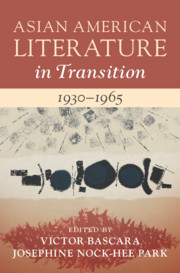Book contents
- Asian American Literature in Transition, 1930–1965
- Asian American Literature In Transition
- Asian American Literature in Transition, 1930–1965
- Copyright page
- Contents
- Figures
- Contributors
- Series Preface
- Introduction
- Part I Transitions Approached through Concepts and History
- Chapter 1 The Popular Front and Asiatic Modes of Cultural Production
- Chapter 2 Asian American Realism
- Chapter 3 On Modernism, Decolonization, and Asian American Literature in Transition
- Chapter 4 The Cultures of Japanese Internment
- Chapter 5 The 1947 Partition, War, and Internment
- Chapter 6 Cold War Fiction
- Chapter 7 Desert, Island, Ocean, Swamp
- Part II Transitions Approached through Authors, Texts, Concepts, and History
- Select Bibliography
- Index
Chapter 2 - Asian American Realism
from Part I - Transitions Approached through Concepts and History
Published online by Cambridge University Press: 27 May 2021
- Asian American Literature in Transition, 1930–1965
- Asian American Literature In Transition
- Asian American Literature in Transition, 1930–1965
- Copyright page
- Contents
- Figures
- Contributors
- Series Preface
- Introduction
- Part I Transitions Approached through Concepts and History
- Chapter 1 The Popular Front and Asiatic Modes of Cultural Production
- Chapter 2 Asian American Realism
- Chapter 3 On Modernism, Decolonization, and Asian American Literature in Transition
- Chapter 4 The Cultures of Japanese Internment
- Chapter 5 The 1947 Partition, War, and Internment
- Chapter 6 Cold War Fiction
- Chapter 7 Desert, Island, Ocean, Swamp
- Part II Transitions Approached through Authors, Texts, Concepts, and History
- Select Bibliography
- Index
Summary
The landmark texts of Asian American literature from the mid-twentieth century have often been classified as realist. Presenting “real-life” depictions of Japanese American incarceration during World War II and the immigrant experience, for instance, Asian American writing of the time is known for its referentiality to historical events. Recently, however, literary critics have sought to redefine the genre of realism, which has also led to a reconsideration of how canonical Asian American literature represented the deeper structure of Asian American life from 1930 to 1965. This chapter traces how Asian American literary critics have offered a more theoretically complex approach to realism in order to help draw out richer understandings of the way Asian American literature has articulated Asian American social experience. In addition, this entry provides brief readings of classic Asian American texts, notably John Okada’s No-No Boy and Carlos Bulosan’s America Is in the Heart, through a realist frame.
- Type
- Chapter
- Information
- Asian American Literature in Transition, 1930–1965 , pp. 38 - 54Publisher: Cambridge University PressPrint publication year: 2021

